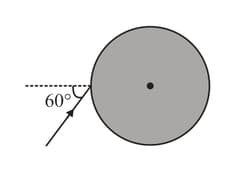Embibe Experts Solutions for Chapter: Ray Optics, Exercise 1: Exercise 1
Embibe Experts Physics Solutions for Exercise - Embibe Experts Solutions for Chapter: Ray Optics, Exercise 1: Exercise 1
Attempt the practice questions on Chapter 17: Ray Optics, Exercise 1: Exercise 1 with hints and solutions to strengthen your understanding. Physics Crash Course JEE Advanced solutions are prepared by Experienced Embibe Experts.
Questions from Embibe Experts Solutions for Chapter: Ray Optics, Exercise 1: Exercise 1 with Hints & Solutions
A concave mirror is placed on a horizontal table, with its axis directed vertically upwards. Let O be the pole of the mirror and C it's centre of curvature. A point object is placed at C. It has a real image, also located at C (a condition called auto-collimation). If the mirror is now filled with water, the image will be:
number of identical equilateral prisms are kept in contact as shown in figure. If deviation through a single prism is . Then ( are integers)

A plane mirror and a concave mirror of radius of curvature are placed facing each other, with a point object at the center of them. If the image formed by first reflection at the spherical mirror and then at the plane mirror coincides with the object then the separation (in ) between two mirrors will be _____ .
A ray of light is incident on a glass sphere of refractive index at an angle of incidence as shown in figure. The total deviation (in degree) suffered by the ray is _____ .

A point object is placed at a distance of on the principal axis of a convex lens of focal length . On the other side of the lens, a convex mirror is placed at a distance of from the lens such that the final image coincides with the object itself. Focal length (in ) of convex mirror is _____ .
A convex lens of focal length and a concave lens of focal length are kept along the same axis with a distance (in ) between them. For what value of does a parallel beam of light incident on leave as a parallel beam?
A converging beam of light forms a sharp image on the screen. A lens is placed in the path of the beam, at a distance of from the screen. It is found that the screen has to be moved further away from the lens to obtain a sharp image. Focal length (magnitude) of lens is ______
Figure shows a graph of angle of deviation versus angle of incidence, for a light ray striking a prism. Angle of prism is _____ degree.

